
Understanding Matejko's painting The Battle of Grunwald
Introduction
The July 15, 1410 battle fought between the villages of Grunwald and Tannenberg - as the village of Stębark was then called - was an epochal event. It was a battle between the Teutonic Knights, a mounted Military Order that had created its own German state along the Baltic Sea north of Poland, and the combined forces of the Kingdom of Poland and the Grand Duchy of Lithuania, recently joined through their ruler, King Własysław Jagiełło. It was a massive encounter pitting 24,000 men at arms on the Teutonic side against 39,000 on the Polish-Lithuanian side. Arguably, it was thus the largest battle of the Middle Ages, dwarfing the battle that took place on October 25, 1415 at Agincourt between the English and French forces that numbered 5900 and 20-30,000 respectively.The battle, which in Germany continues to be referred to as the Battle of Tannenberg, has very much continued to live on in the consciousness of both Poles and Germans. In Poland, Grunwald remains a rallying cry for Polish patriotism. There is hardly a major town without its Grunwald Avenue, Square, Street or Cinema. The battle is viewed as having stemmed, for a time at least, the German "Drag nach Osten" (Push to the East), the Eastward quest of lands for settlement and trade, and thereby also to have prevented the otherwise likely Germanization of the country. In Germany also, Tannenberg has not been forgotten. Thus, for instance, when in late August 1914 in East Prussia the German Army faced 100,000 strong Russian Second Army, General, later Field Marshal, von Hindenburg is reputed to have said to General Ludendorf "Come on Ludi, let's get our own back for 1410" or words to that effect. The Russian army was duly annihilated in what is considered the most spectacular and complete German victory of the First World War. Thereafter, the encounter became known in Germany as the Second Battle of Tannenberg, presumably viewing it as a reprisal for the defeat suffered 500 years earlier at the hands Poles/Lithuanians, also Slavs.
When viewing the painting, it is well to be aware of the historical context of the time when it was created. To start with, over time, the Teutonic State morphed into the Kingdom of Prussia, an entity that participated in the 18th Century partition of the Polish State, annexing 20% Poland's territory in the process. Then the decade of the 1870s saw the rise of Prussia to unprecedented power. First, in 1970, the year in which Majeko conceived the painting The Battle of Grunwald, a coalition of German states led by Prussia defeated the Armies of France and besieged Paris. The following year, saw the successful culminations of Bismark's efforts to unify Germany, a process that led the King of Prussian becoming the German Emperor. Meanwhile the efforts to germanize the areas of Poland in the German partition intensified significantly. The can be little question that in deciding to create a painting of the ancient battle, Matejko had political motives in mind, wanting to remind his fellow Poles of their former success and thereby to give them both hope and incentive to resist the germanization efforts.
The Painting
The Battle of Grunwald is a huge painting 10 feet high and almost 17 feet in length. It's full of figures and action and, because of its size, difficult to uniformly illuminate and photograph. Reproductions tend to miniaturize it to the point that only a couple of highlights are discernable and much of the rest of the painting's detail is lost. Even when standing before it, visitors find it hard, initially, to come to terms with its complexity. Yet it was considered by Matejko's fellow citizens a towering masterpiece, so much so that the Council of the City of Krakow voted to give Matejko the title of King of the Arts and to present him with a golden Royal scepter in recognition of this honor. Jan Matejko Battle of Grunwald, 1874 , oil on canvas, 16'7"x9'9", National Museum, Warsaw |
Secondly, the painting engages the viewer in three progressive levels of contemplation and analysis. At first, it's seen as a scene of furious battle, of warriors, weapons, horses and more. The tableau is dominated, on right of center, by the figure of Witold, the Grand Duke of Lithuania, triumphally raising his arms in what could be compared to a victorious gesture of latter day politicians, no matter that on a moving horse he could not long remain in the saddle in such a pose. On the left of center the painting is dominated by the figure of Ulrich von Jungengen, Grand Master of the Order, who perished in the battle. Under attack from various quarters, Jungengen is about to lose his life.
Once the viewer's eyes leave the highlighted figures, they are attracted to the large number of other events portrayed in the painting. Contemplating these leads most first time viewers to a state of confusion, a feeling perhaps best captured by Stanisław Wyspiański in his parody of the master's painting, portraying a mass of interweaving lines from among which emerges a inclined Teutonic banner. The events portrayed on Matejko's canvas require careful study and acquire meaning as the identity and historical roles of those involved becomes known. It is only then that the third level of analysis, which focuses on otherwise hidden symbolism that Matejko had incorporated into the painting, can be undertaken.
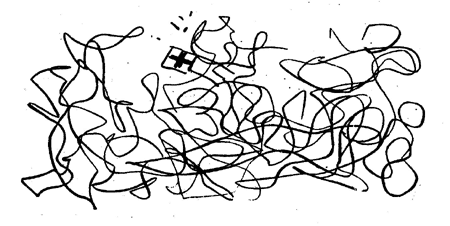 Stanisław Wyspiański J. Matejko's Battle of Grunwald drawing |
It's true that there are few paintings by Matejko in which there is such a confusion of figures and time periods. as in the Battle of Grunwald. Among the sources of information on which the artist, similarly to Henryk Sienkiewicz (who described the battle in his book The Teutonic Knights) based his portrayal, foremost was the chronicle of Jan Długosz. The historiographer's explicit description was in turn supposedly based on the accounts of his own father, a participant in the battle. Nonetheless Długosz was guided, in large measure, by his own feelings and emotions - hence his vision of Grunwald requires today revisions or at least prudence. We know now that on the Polish side King Wladyslaw Jagiełło was in command, while in Matejko work, in the footsteps of Długosz and Sienkiewicz, the central figure is the Grand Duke of Lithuania, Witold. Other matters were also rendered in the traditional fashion. The documentation by the Swedish historian Svena Ekdahl a few years ago have show beyond doubt that the famous trap and the death of Ulrich von Jungingen at the hand of the peasant infantry are legends. In reality the Grand Master was slain in a mounted battle. Peasant were present but on the branches and trunks of the surrounding oaks ... as spectators of a battle which basically didn't concern them.
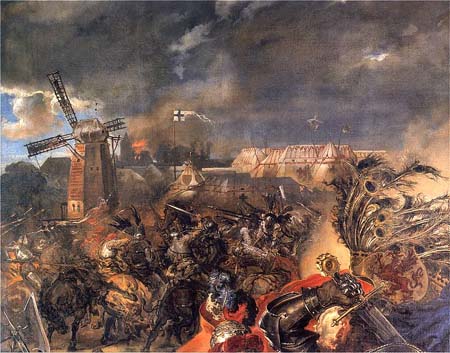 The Teutonic camp |
In contrast to portrayal of the battle itself, the area around Grunwald and its landscape are rendered very accurately. In 1877, Matejko visited the field of battle and, after returning to Krakow, made a number of correction in the perspective of the painting already in progress. Photographs of the earlier version at the Jan Matejko Museum in Krakow, make it evident that the artist improved upon and corrected details of the landscape at the cost, however, of the artistic qualities of the painting.
Whoever undertakes an analysis of the symbolism of the Matejko's Grunwald, has to keep in mind the difficulty of the task and that elucidation of all the features evident in the painting is almost impossible. One has to approach this work by first focusing on the whole, then details, gradually retreating through the lens of our eyes so as to discover relationships of individual figures, and then again look at the work as a whole. Naturally, careful viewing of The Battle of Grunwald is enhanced by concrete knowledge of the battle, of the historical figures portrayed, and finally about 19th century Krakow and Matejko himself. Special attention has to be given to the figures which were identified in a separate key by the painter himself: the symbolism then become much more understandable.
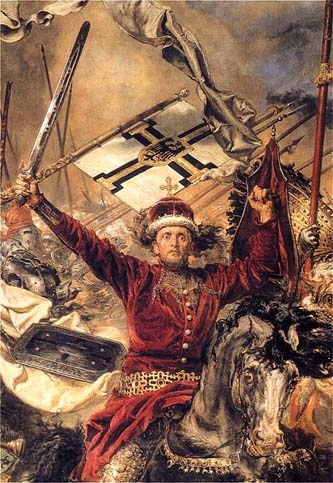 Grand Duke Witold |
Witold's Christian faith was of relatively recent date, hence also the cross on the top of the ducal coronet is not very large and mounted in a neophyte fashion. It stands proudly while another, the much larger cross of the Grand Master's banner, forming the background, tilts towards a fall. Let us consider yet another property of the figure: it's the only one in the painting, among those of significant individuals, whose gaze is directed outwardly from the painting in the direction of the spectator. In spite of the suggestion to the contrary, this isn't a man leading a charge into the battle. Individual Polish knights are already fighting in the midst of the crush of battle. The figure gives the impression of one who is rushing blindly, anyhow, and would most want to remove himself from the field of battle, not because of cowardice but due to his internal desperation. Even if he had been leading knights into battle, he has long since separated from them. The whole portrayal of Witold is a marvelous psychological study of the Lithuanian prince. - not at all so one sided as it is frequently accepted. For amusement we can digress from our discussion to note that the design of the knightly belt worn by Witold, is one Matejko borrowed from a lampshade in his house. Of course, no symbolism is attached. We mention this on purpose so as to worn against forced interpretations and a search for symbolism of items for which the artist had presumably none such in mind.
Next to Witold, Marcin from Wrocimowic, coat of arms Półkoza, holds firmly in his hand the Great Standard of the Kingdom (for he was the Royal Standardbearer). In the painting he is presented in the full armor of a hussars, clearly pointing to the tie in the traditions of Grunwald with those of Kirchholm, Chocimin, and Vienna.[1] Marcin is sounding the horn of triumph, and the staff of the standard he holds is topped by an unusual finial made-up of a sharp pike and a spiny orb that recalls the end of the morgendtern, a menacing weapon of the middle ages. It's a clear allusion to the loss of the standard during the battle, and at the same time a warning: woe betide him who would raise his arm against the symbol of the Kingdom.
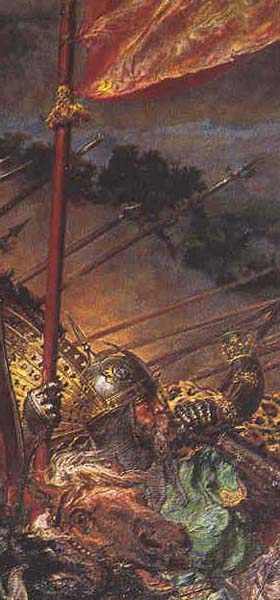 Marcin from Wrocimowic | 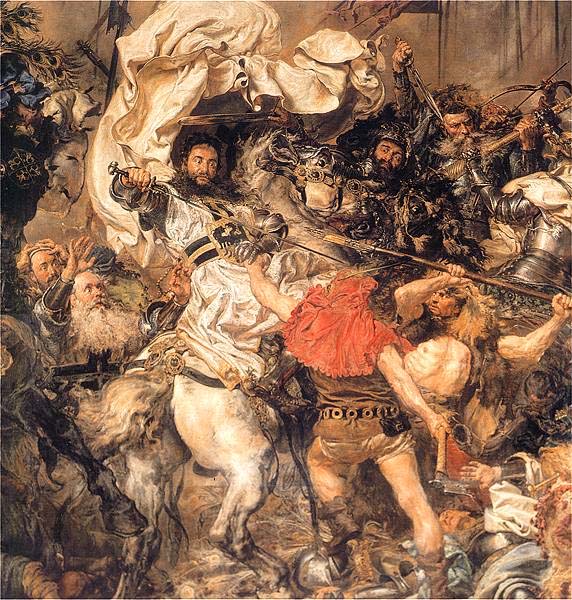 Ulirich von Jungengen, Grand Master of the Order |
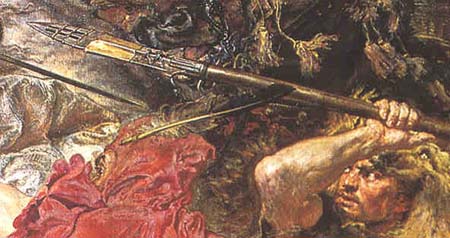 The spear of St. Maurice |
But that's not the end of it. Zyndram from Maszkowic, the Krakow sword-bearer, appear to lift aside with his sword Jurgeingen's crusader coat bellowing in the wind (and wind there was on that July day, just before the rain, as the chronicles confirm). But this is portrayed in such a way that symbolically it as if the sword of justice were hanging over the head of the Teutonic commander - a symbol of a death verdict. During the battle, Zyndram was responsible for the great banner of the Kingdom, and since for a period it was lost, in spite of the victory he was removed from his office and replaced by Jakub from Kobylan. It was not by accident that the painter shows him somewhat removed from the symbol he ought to have been protecting: He pushed his way to the Grand Master, looking for glory as the dispatcher of the enemy commander, but failed to mind that with which had been entrusted.
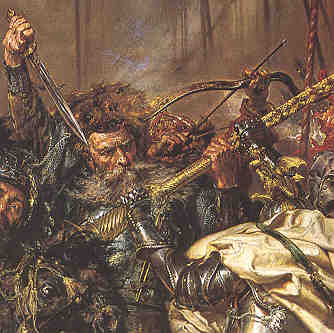 Mikołaj Skunarowski |
Mowing slightly to the left and down from the figure of the Grand Master, Werner von Tettingen, the Commander of Eblong, responsible for the medical care of the Teutonic Order's Army, acknowledges, with a gesture of despair, the death of the Grand Master. He himself, however, would survive, the only one among the Order's leaders.
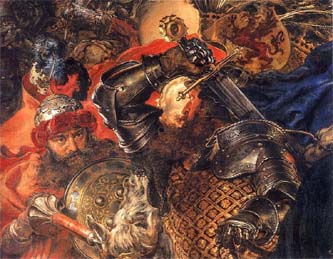 Jakub Skarbka and Kazimierz of Szczecin |
In the bottom of the central portion of the painting, Matejko portrays Konrad VII Bialy, Prince of Olesnica and Kozul, unhorsed and later taken prisoner. He is shown (no enlarged visual of this detail is available) in an unequivocally in a negative light. He holds in his hand ... one of the three Jagiełłonian University extant maces. That's an explicit allusion to perfidy of the Prince who, as a young page, was brought up at the Royal Court of Queen Anna Cylejka, the wife of Jagiełło. He had to have become estranged from Poland at an early age since he took the field at Grunwald on the side of the Teutonic Order when he was just 18 years old. After being ransomed from captivity in 1411, he changed alliances several times. Such faithlessness was quite common in the Middle Ages and didn't have the negative connotations that it has today and already had in the 19th century when Matejko's painting was being created. During the Middle Ages one served not one's nation of state, but - In accordance with the feudal law - one's ruler, the Prince or the lord to whom one owed allegiance. As a consequence individuals even relatives, entering the order of battle on opposite sides were frequently totally indifferent to the matter at hand, constrained - under threat of infamy and loss of land - by the need to fulfill feudal responsibilities. A knight was the owner of land but also battle technician - hence post-battle feasts of the victors and the vanquished were not that rare since, emotionally, they didn't have anything against each other. Only with the passage of centuries did our current understanding of valor and cowardice, treachery and faithfulness, patriotism and renegade develop. Matejko understood how these matters were viewed in the Middle Ages and he thus he represented them in his works. The portrait of the young disloyal Konrad, created in the Battle of Grunwald by the painter, is an exception because Konrad was a Piast, a member of Poland's ancient Royal clan. He's the only Piast prince painted by Matejko on the Teutonic Order side. Konrad of Szczecin, as a Gryfit, was not counted as a Piast.
Let's go back however to Jakub Skarbka and the Szczecin Prince, Kazimierz. The former, armed almost entirely in the Oriental mode, appears like a guest. This agrees with historical facts, since he came to Poland on the news of the war with the Teutonic Order, leaving behind a lucrative position at the Court of Zygmunt the King of Hungary. On the other hand the gryphon, griffin, griffon on the helmet of Prince Kazimerz is as if identification of his person by the artist, who left for the viewer the matter of underlying moral context.
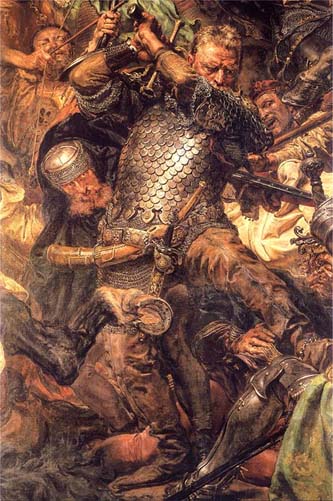 Jan Żiżka |
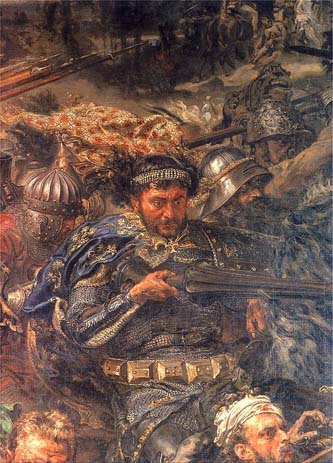 Zawisza Czarny |
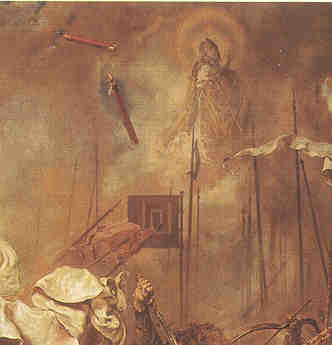 St. Stanisław |
In the painting, the banners of the Kingdom and that of Jagiełło flutter triumphally, while that of the Grand Master is toppling forward and falling - but this is not the great banner of the Order, which of course survived, although much perturbed. Overhead one can also see the banner with Pillars of Gediminas, the grandfather of both Jagiello and Grand Duke Witold, thus a symbol of the Lithuanian dynasty. On the far right of the painting is visible the banner of the town of Braunsburg (now Braniewo) which features two crosses, one black, the other white. It's tempting to speculate that Matejko chose to represent this particular banner because the crosses have a shape analogous to that continued to be used by Prussia and later Germany in their insignia and medals.[2] Above the battle, in the clouds is visible the figure of St. Stanisław, the patron saint of Poland. After the battle there were many claims, particularly among on the Teutonic side that St. Stanisław, was present and helped the Poles achieve victory. of is concerned, the war with the Teutonic Order was more of a personal, dynastic conflict than one between states. The broken pieces of a knightly lances gliding below the saint's figure are supposed to indicate the fury of the battle - its hard to attach any symbolism to them.
There are many more symbolic details possible to discern in Matejko's painting. But enough has been said to give an idea of the enormous effort carried out by the artist. Matejko's Battle of Grunwald could the subject of a separate book, without any guarantee that it would exhaust the subject and discovery of all the meaning and symbols hidden within it by the artist.
The Battle of Grunwald surprised, shocked and gave rise to various emotions. In spite of some, for him usual, pointed comments, the painting made a lasting impression on Stanisław Wyspianski, who in his drama Julius II compared the battle's choas with the Sistine Chapel frescos by Michelangelo, since also Buonarroti, in the context of his Last Judgment, reminds one all to clearly of Matejko in the context of his Grunwald. In his incomparable Wedding, the poet in the words of the Black Knight (Zawisza Czarny), frankly, describes Matejko's painting:
|
You will tremble at my voice: Grunwald, swords, King Jagiełło! Cutting through the armor, as the gale howled and blew; mounds of corpses, mounds of bodies, and the blood flowed in a river. That's it is! The work of Giants: Witold, Zawisza, Jagiełło, there it is! On the battlefield armor gleams in the trenches, javelins, and broken spearpoints, shafts driven through bodies, a dam of corpses, a dike of corpses, a mound made up of knights...[3] |
Grunwald has been the subject of earlier works by Matejko and later works by others, Nonetheless it is Matejko's great magnificent Battle of Grunwald completed in 1878, that continues to dominate memory. No wonder that on the 29th of October of that year, the City Council of Krakow presented Matejko with an honorary decorated scepter as a sign that he ruled over Polish art. The ideal was reaching ... its summit. The questioning by specialist of Polish armaments and colors, artistic purists and estheticists, didn't hurt it renown. The power of expression on Matejko's canvas was such, that when Wojciech Kossak, commissioned by the Museum of the Polish Army, created a very factually correct painting on the same subject, it didn't even in to a slight degree garner the fame of the one by Matejko. It was after Matejko's painting that, during their wartime period of German occupation, was the object of a furious and detailed search. The Germans were however unsuccessful in their search because of the many Polish patriots who risked their lives to keep it hidden. Kossak's painting, on the other hand, didn't even elicit the Germans' interest. And in 1999, the exhibition of the Battle on Grunwald in Lithuania created enormous emotions among the people of that country for whom viewing of the monumental painting became the object of a national pilgrimage.
Notes: 1. Kirchholm: location, currently in Latvia, of the 1605 battle against Sweden; Vienna, location of the 1683 raising of the Turkish siege of the City by joint Polish and Austrian forces.
2. See photo of Field Marshal Paul von Hindenberg
3. Translation: Stanislaw Wyspianski: The Wedding by Gerard T. Kopolka, Ann Arbor, Ardis, p105, (1990)
| Info-Poland a clearinghouse of information about Poland, Polish Universities, Polish Studies, etc. |